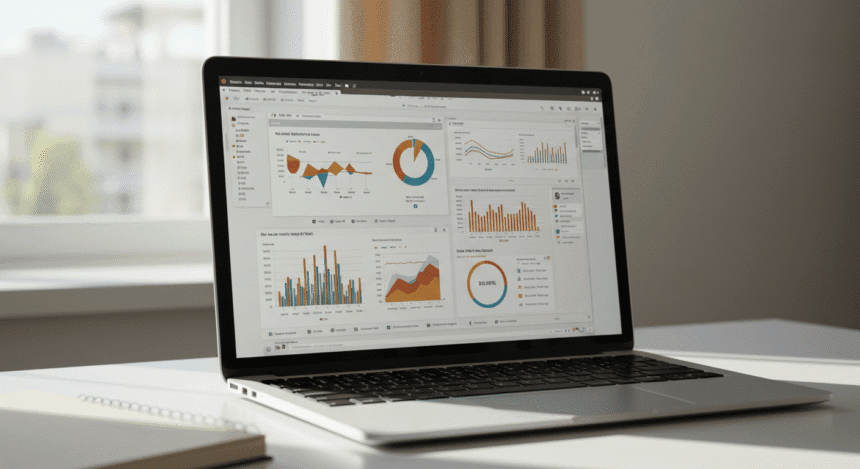We have been blogging about the role of AI in business since Ryan took over the site over a decade ago. One of the most popular areas of focus has been how companies use it to improve website performance and customer experience.
You might think that every business is already using AI to improve how their site works, but the truth is more complicated. SurveyMonkey found that 56% of brand leaders say their companies are actively using AI, but 44% are still waiting on more data. Keep reading to learn more.
Personalizing Customer Experience
There are all kinds of ways AI can make a website feel more personal. You can track how users behave on your site and adjust your recommendations in real time. It is this kind of fast feedback loop that helps customers feel like the site understands their needs. You don’t have to redesign your whole platform to make that happen either.
You can also use AI to figure out which designs keep people on the page longer. There are subtle patterns in how users scroll or click that a person might miss but an algorithm can detect. It is one of the easiest ways to spot design problems before they become expensive mistakes.
There are still major gaps in how U.S. companies are using these tools. Lornah Ngugi reports that 60% of businesses already use AI to personalize the experience, but only 26% are using it to improve how well their content ranks on search engines. You should take that as a sign that there’s still time to get ahead of your competitors.
It is not just about customer-facing improvements either. You can also use the same tools to test backend issues like server response time or code changes. There are reports that AI can help flag bugs before they reach production, which can save a lot of time and money.
As a digital accessibility expert, I’ve spent the last few years leading accessibility efforts on large Drupal projects, building internal QA workflows, and helping teams understand how accessibility can either quietly elevate their product or completely tank its user experience.
The biggest shift I’ve seen recently? Businesses are finally starting to treat web accessibility not as an optional add-on, but as a core requirement. It’s being driven by rising user expectations, evolving tech stacks, and — let’s be honest — looming legal deadlines.
If you’re not running proper web accessibility evaluations by 2025, you’re either lucky or overdue. And if you’re not using the right tools, you’re not just wasting time — you’re shipping products that don’t work for real people.
In this article, I want to walk you through the top free tools I personally use when testing websites for accessibility. These are the browser extensions and utilities I rely on when clients say, “We think our site is fine — can you take a quick look?”
I’ll explain what these tools can do, what they can’t, and how to use them wisely — whether you’re a developer, product owner, or someone just trying to understand where your site stands.
Why web accessibility matters more than ever
Before we dive into tools, let’s zoom out.
When I explain web accessibility to clients, I keep it simple: it’s about making websites usable for everyone. That includes users with permanent disabilities (like visual or motor impairments), people with temporary challenges (like a broken wrist or eye strain), and those in constrained environments — bright sunlight, low bandwidth, noisy rooms.
But here’s what I emphasize most: everyone benefits from accessibility eventually.
That includes you trying to book a flight on your phone in a car. Or your parents struggling to navigate an app with small touch targets. Accessibility isn’t just about “others.” It’s about the reality of being human.
And in 2025, it’s also about legal compliance. The European Accessibility Act goes into effect this June, requiring digital products in many industries to meet strict web accessibility evaluation standards. Failure to comply can mean fines, lawsuits, and reputational harm — especially for companies working in finance, ecommerce, travel, healthcare, or public services.
So if your team hasn’t started building an accessibility workflow yet, the next best time is now.
What web accessibility tools can (and can’t) do
I’ve seen this happen often: a team installs a fancy web accessibility checker tool, runs it once, gets a list of warnings, fixes a few items — and assumes the job’s done.
Spoiler: it’s not.
No matter how advanced, every automated web accessibility tool has limits. They’re essential for coverage and consistency, but they won’t catch everything.
Here’s what tools are great for:
- Flagging missing labels or attributes
- Identifying broken heading hierarchies
- Detecting low color contrast
- Highlighting missing roles and landmarks.
Here’s what they won’t tell you:
- Whether your keyboard navigation makes sense
- If your focus order is intuitive
- Whether custom components are usable with assistive tech
- If your error states are accessible and clear.
That’s why I treat tools as the first step, not the final answer. They’re a web accessibility test tool, not a replacement for real user testing.
With that in mind, here are the tools I recommend and why.
1. Axe DevTools: a solid foundation for automated testing
If I had to pick a single web accessibility evaluation tool to recommend to any team, it would be Axe DevTools by Deque Systems.
This Chrome extension integrates directly into your browser’s DevTools panel and lets you scan pages for accessibility violations in seconds. It checks for:
- Missing or malformed ARIA attributes
- Color contrast failures
- Improper semantic structure
- Inaccessible elements like buttons or links without names.
The free version is robust enough for small projects or quick scans. The Pro version adds reporting, team collaboration, and CI/CD integrations but you can still do a lot without it.
Why I use it: It’s fast, reliable, and respected in the accessibility community. Plus, it flags both WCAG 2.1 A/AA violations and best practice issues.
What it misses: Anything involving keyboard navigation, focus state visibility, or complex interactions.
Verdict: The best all-around web accessibility tool for developers who want to catch the basics quickly and cleanly.
2. HeadingsMap: see your heading structure instantly
Your page’s heading hierarchy is more important than you think. It guides screen readers, defines document structure, and affects SEO. But many sites jumble their headings: jumping from H1 to H4, skipping levels, or using headings for layout only.
HeadingsMap is a lightweight Chrome extension that shows you the full outline of your headings on any page. It color-codes issues like skipped levels or repeated tags.
Why I use it: It gives instant feedback. No need to inspect code, you can see structural problems at a glance.
What it misses: It won’t catch visual-only “headings” (like <div>s styled to look like H2s).
Verdict: An essential web accessibility evaluation tool for checking semantic structure, especially on content-heavy pages.
3. Taba11y: test your tab order with one click
Keyboard accessibility is foundational. If users can’t navigate your site using only the Tab key, it’s not accessible — period.
Taba11y simulates tabbing through a page and shows you the focus order visually. It highlights the path of tabbing, reveals skipped elements, and helps detect focus traps.
Why I use it: It’s fast, visual, and reveals focus loops that even experienced devs sometimes miss.
What it misses: It can’t tell you if focus looks right (i.e., visible indicators). You’ll still need to test that manually.
Verdict: A smart, simple web accessibility test tool to confirm navigability — great for both devs and QAs.
4. WAVE (Web Accessibility Evaluation Tool): one panel to rule them all?
Built by WebAIM, WAVE is often cited in discussions about which tool is integrated into Chrome’s developer tools for auditing web accessibility? It’s not built-in, but it’s widely used.
It combines several tests in one interface: structure, contrast, ARIA roles, alternative text, and more.
Why I use it (sparingly): It gives a broad overview, especially when onboarding new projects.
Why I don’t rely on it: The UI is dated, the results can be overwhelming, and the signal-to-noise ratio isn’t great. Still, some teams prefer having everything in one place.
Verdict: A decent fallback or supplement. Best for audits where a general overview is needed or if you’re working with teams who already use it.
The real gaps: what no tool will show you
Even the best web accessibility checker tool will miss certain issues. That’s why I always run manual tests alongside automated ones. Here’s what I check manually on every project:
- Keyboard-only navigation: Can I reach every interactive element using only Tab, Shift+Tab, and Enter?
- Focus states: Are they clearly visible on buttons, links, and forms?
- Screen reader behavior: Do headings, roles, and labels make sense when read aloud?
- Form validation: Are error messages announced correctly?
- Modal behavior: Is focus trapped inside, and does it return to the trigger when closed?
In our Drupal QA process, these checks are baked into our workflow and they uncover issues no tool can.
Accessibility by role: how each team member benefits from tools
These tools aren’t just for developers. I encourage every team member to use them. Here’s why:
Developers:
Catch issues before handing off to QA. Confirm your markup is valid. Build muscle memory around ARIA and semantics.
QA testers:
Add automated scans to your test plans. Use tab order tools to verify keyboard coverage. Surface regressions early.
Product managers:
Install Axe DevTools, scan your homepage, and get a reality check. You’ll understand how real users might struggle and how to prioritize fixes.
Marketers:
Think accessibility doesn’t concern you? Think again. Inclusive design is now part of brand reputation. And if your site fails, it’s your budget that shrinks when legal trouble hits.
Looking for an elderly-friendly web accessibility tool?
A quick note for those designing for older users: accessibility isn’t just about disabilities — it’s about natural limitations that come with age. That includes slower reaction time, reduced vision, and less comfort with complex UI.
While no tool is age-specific, a combination of Axe, HeadingsMap, and Taba11y provides excellent coverage. They help ensure that your site:
- Has clear structure
- Uses readable contrast
- Supports keyboard use
- Minimizes complex interactions.
These are key ingredients in building inclusive, age-friendly interfaces.
When to bring in consultants
Even if you’re using the best web accessibility AI tool or top-rated automated web accessibility tool, you may still need help.
A good consultant doesn’t just run scans. We simulate real-world scenarios:
- Users navigating with only a keyboard
- People using screen readers or magnifiers
- Low-bandwidth or mobile-only situations
- Users under cognitive or emotional stress.
We also help you move from reactive to proactive — embedding accessibility in your design reviews, planning sessions, and code reviews. If that sounds like where you want to be, our consulting Drupal services are a good place to start.
Final thoughts: tools are the spark, not the solution
You don’t need to fix everything at once. But you do need to start, especially with 2025’s legal and ethical expectations looming.
Here’s your starter plan:
- Install Axe DevTools, HeadingsMap, and Taba11y
- Run a quick scan of your homepage
- Document the issues you find
- Test your forms and modals with just a keyboard
- Ask your team: what would it take to fix these before June?
That’s it. No budget approval required. No waiting for a sprint.
Every small improvement you make opens the door to someone who couldn’t get in before. That’s what real web accessibility is: empathy, at scale. And these tools? They’re the first steps toward building a web that works for everyone.











